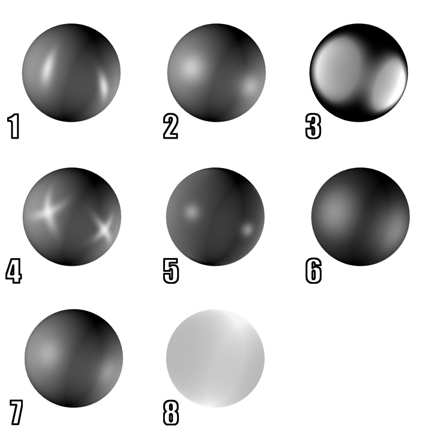The Standard and Raytrace materials let you specify a shading type. A "shader" is an algorithm that describes how the surface responds to light. One of the most noticeable features of each shader is how it generates specular highlights.

Samples of different shading for a standard material
1. Anisotropic
2. Blinn
3. Metal
4. Multi-layer
5. Oren-Nayar-Blinn
6. Phong
7. Strauss
8. Translucent
Some shaders are named for what they do, such as the Metal and Translucent shaders; others are named for the person who developed them, such as the Blinn and Strauss shaders.
Several different shaders are provided with 3ds Max. Some of these are not available for the Raytrace material.
The Anisotropic shader creates surfaces with elliptical, "anisotropic" highlights. These highlights are good for modeling hair, glass, or brushed metal. The basic parameters are similar to those for Blinn or Phong shading, except for the Specular Highlight parameters, and Diffuse Level controls such as those for Oren-Nayar-Blinn shading.
Blinn shading is a subtle variation on Phong shading. The most noticeable difference is that highlights appear rounder. In general, you don't need to use the Soften parameter (described in Blinn, Oren-Nayar-Blinn, and Phong Highlights) as often as you do with Phong shading.
Metal shading provides realistic-looking metallic surfaces and a variety of organic-looking materials.
The Multi-Layer shader is similar to the Anisotropic shader, but it has a set of two specular highlight controls. The highlights are layered, letting you create complex highlights that are good for highly polished surfaces, special effects, and so on.
The Oren-Nayar-Blinn shader is a variant of the Blinn shader. It contains additional "advanced diffuse" controls, Diffuse Level and Roughness, that you can use to give the material a matte effect. This shader is good for matte surfaces such as fabric, terra cotta, and so on.
Phong shading smoothes the edges between faces and renders highlights realistically for shiny, regular surfaces. This shader interpolates intensities across a face based on the averaged face normals of adjacent faces. It calculates the normal for every pixel of the face.
The Strauss shader is for modeling metallic surfaces. It uses a simpler model and has a simpler interface than the Metal shader.
Translucent shading is similar to Blinn shading, but it also lets you specify translucency. A translucent object allows light to pass through, and also scatters light within the object. You can use translucency to simulate frosted and etched glass.